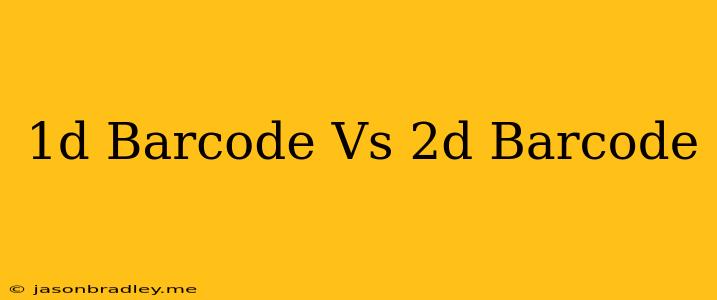Here is an article about 1D vs 2D barcodes:
1D vs. 2D Barcodes: Which One Is Right for You?
Barcodes are ubiquitous in our daily lives, from scanning groceries at the checkout to accessing boarding passes at the airport. But did you know that there are different types of barcodes? Two of the most common types are 1D barcodes and 2D barcodes.
What is a 1D barcode?
A 1D barcode, also known as a linear barcode, is a barcode that represents data as a series of vertical lines of varying widths and spacing. These lines are read by a barcode scanner and converted into a string of data.
Examples of 1D barcodes include:
- UPC (Universal Product Code) - found on most consumer products
- EAN (European Article Number) - similar to UPC, used in Europe
- Code 39 - used in various applications, including inventory management
- Code 128 - used for shipping and logistics
What is a 2D barcode?
A 2D barcode, also known as a matrix barcode, uses a two-dimensional pattern of dots, squares, or other shapes to represent data. These barcodes can store significantly more data than 1D barcodes, and they are also more resistant to damage and dirt.
Examples of 2D barcodes include:
- QR (Quick Response) Code - widely used for mobile payments, website access, and social media sharing
- Data Matrix - used for product identification, tracking, and authentication
- Aztec Code - capable of storing large amounts of data, used in transportation and logistics
- PDF417 - used for driver's licenses and other identification documents
1D vs. 2D Barcodes: A Comparison
Here is a table that summarizes the key differences between 1D and 2D barcodes:
| Feature | 1D Barcode | 2D Barcode |
|---|---|---|
| Data Storage | Limited | High |
| Encoding | Linear | 2D Pattern |
| Readability | Easy | Requires 2D Scanner |
| Error Correction | Limited | Robust |
| Applications | Product Tracking, Inventory Management | Mobile Payments, Website Access, Identification Documents |
Which barcode is right for you?
The best type of barcode for your needs depends on your specific application. If you need to store a large amount of data, use a 2D barcode. If you need a barcode that is easily readable by standard scanners, use a 1D barcode.
Here is a general guideline:
- Use 1D barcodes for: Simple tracking, inventory management, and product labeling
- Use 2D barcodes for: Mobile payments, website access, social media sharing, identification documents, and high-capacity data storage
By understanding the differences between 1D and 2D barcodes, you can choose the best option for your needs and improve your data storage and retrieval capabilities.
